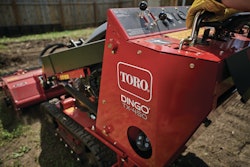You can’t just load a piece of equipment onto a trailer, hitch it to any old truck and then take off. When you trailer equipment, there is a lot to think about – trailer capacity, tiedown regulations, balancing the load – so make the task easier by combining common sense with knowing the rules.
Loading your trailer
Before you haul your equipment, know exactly how much your equipment weighs, your trailer’s capacity and the capacity of your tow vehicle. According to Galen Siedner, general manager of Pro Hauler Trailers, Compact Power, most half-ton pickup trucks will tow up to 5,500 pounds, while a 3/4-ton pickup truck can generally handle up to 10,000 pounds.
For proper load balance, make sure you have the correct tongue weight for the trailer. Seidner says the proper tongue weight is approximately 10 to 15 percent of your total gross vehicle weight – your cargo load and trailer weight combined. “For example, with a 3,000-pound trailer and 5,000 pounds of equipment, the tongue weight should be between 800 and 1,200 pounds,” Seidner says. You should always center the equipment over the axle or axles for the best weight distribution. Trailers like Compact Power’s mini-skid system line are designed so the operator can safely load or unload equipment in either the forward direction or by backing up.
The right trailer can make the job easier with features designed specifically to improve safety when loading. Jan Oehlerking, sales director, Trail-eze, says they designed their TE0XT model with hard-to-load equipment in mind. “This trailer has a great load angle with no moving axles,” Oehlerking says. “It will keep your axles in the same location as our old hydraulic tail trailer. This allows small tire equipment to load as easily as larger equipment and you never have to worry about axle alignment.” Oehlerking says the load angle makes it easy to retrieve downed pieces of equipment. Trail-eze also offers a 35-ton sliding axle trailer.
Trail King has also recognized the importance of a low load angle, creating a sliding axle trailer for their Advantage Series. Phil Riley, national sales manager for Trail King, says the wheels on the sliding axle trailer can move forward a full 212 inches. “This creates a 61/2- degree load angle, which makes this suited for loading and unloading equipment with low ground clearance, such as pavers,” Riley says.
Riley says a hydraulic detachable gooseneck trailer is a good option for one-person loading because of the self-lifting hydraulic cylinders, non-ground bearing design and v-shaped alignment. “It makes detaching, loading or unloading and hookup a quick, easy one-man operation even in the less than ideal loading and unloading conditions of most worksites.”
Tiedown requirements
When you buy your trailer, it will be equipped with load containment devices for you to secure your equipment. But the manual that comes with your trailer won’t tell you what’s required – those rules are set by the state and federal departments of transportation. Federal regulations outline minimum standards and require you not only take steps to prevent losing your load, but also to keep it from shifting.
With respect to performance criteria, your load containment devices must be capable of withstanding certain levels of g forces. And you have to prevent your trailered equipment from vertical movement – your tiedowns must create a downward force equal to at least 20 percent of the weight of the equipment you are hauling.
You also need find out if the working load limit (WLL) of the trailer’s load containment devices is appropriate for the equipment it will carry. David dePoincy, account representative for Transcraft, says the company installs chain ties, D-rings, a winch track with sliding winches, a permanent weld on winches and stake pockets that can be chained, each certified with a working load limit of 5,020 pounds. “Multiple securement points may be needed to properly secure the load, depending on the size and weight of the load,” dePoincy says.
The trailer manufacturer can tell you the WLLs for the tiedowns on your trailer. The WLL of a tiedown is the lowest limit for any of its components or the anchor point to which it is attached. One tiedown is required for a piece of equipment less than 5 feet in length and weighing less than 1,100 pounds. If the equipment exceeds 1,100 pounds or is between 5 and 10 feet in length, two tiedowns are required. For equipment longer than 10 feet, you must use two tiedowns, plus another tiedown for each additional ten feet of length.
Inspecting your tiedowns before each trip is a good habit to form. Remember, tiedowns and securing devices must not contain knots. If the tiedown has been repaired, it must be repaired in accordance with the manufacturer’s instructions. Look at where your tiedown touches your cargo. If it could abrade or be cut, you are required to use edge protection that will resist abrasion, cutting and crushing. The tiedown must prevent the equipment from moving; however, except for steel strapping, tiedowns also must be designed so that the vehicle driver can tighten them. And tiedowns must be attached as closely as possible to the front and rear of the vehicle.
Take care to prepare your equipment for transport. Lower and secure any attachments such as hydraulic shovels when you load the trailer. You must also restrain crawler tracks and wheels using at least four tiedowns to prevent the machine from moving in a forward, backward, lateral or vertical direction.
You can find out more information about cargo securement at this site. Remember, state regulations vary, so find out what requirements apply to you by visiting this site.









